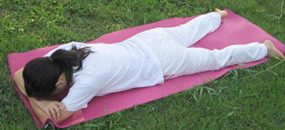Makarasana
Makarasana or Crocodile Pose is a yoga posture (asana) that is often used for relaxation and recuperation. It is a gentle restorative pose that is suitable for practitioners of all levels, including beginners. Makarasana is particularly beneficial for reducing stress and tension, and it is often used as a preparatory or concluding pose in yoga sequences.
Etymology[edit | edit source]
The name Makarasana is derived from the Sanskrit words makara, meaning "crocodile," and asana, meaning "pose" or "posture." The pose is named for its resemblance to a crocodile resting in the water, with its face and neck above the surface.
Description[edit | edit source]
In Makarasana, the practitioner lies prone on the floor, with the legs extended and the feet hip-width apart. The elbows are bent, and the hands are positioned under the shoulders or extended forward, allowing the chest and head to gently rest either on the hands or on the floor. This position helps in releasing tension in the shoulders, back, and neck, promoting relaxation and easing fatigue.
Benefits[edit | edit source]
Makarasana offers several health benefits, including:
- Reduction of stress and anxiety
- Relief from back pain and tension
- Improved circulation and digestion
- Enhanced respiratory function
This pose is particularly beneficial for individuals who spend long hours sitting or standing, as it helps in stretching and relaxing the back muscles.
Precautions[edit | edit source]
While Makarasana is generally considered safe for most practitioners, individuals with severe back injuries, recent surgery, or chronic conditions should consult with a healthcare provider or a qualified yoga instructor before practicing this or any other yoga pose.
Variations[edit | edit source]
Several variations of Makarasana can be practiced to accommodate different levels of flexibility and comfort. These variations may involve adjusting the position of the hands, legs, or head to increase or decrease the intensity of the stretch.
In Yoga Sequences[edit | edit source]
Makarasana is often included in yoga sequences as a gentle transition pose or as a restorative posture towards the end of a practice. It serves as an effective counterpose to backbends and strenuous forward bends, helping to balance the body and calm the mind.
Search WikiMD
Ad.Tired of being Overweight? Try W8MD's NYC physician weight loss.
Semaglutide (Ozempic / Wegovy and Tirzepatide (Mounjaro / Zepbound) available. Call 718 946 5500.
Advertise on WikiMD
|
WikiMD's Wellness Encyclopedia |
| Let Food Be Thy Medicine Medicine Thy Food - Hippocrates |
Translate this page: - East Asian
中文,
日本,
한국어,
South Asian
हिन्दी,
தமிழ்,
తెలుగు,
Urdu,
ಕನ್ನಡ,
Southeast Asian
Indonesian,
Vietnamese,
Thai,
မြန်မာဘာသာ,
বাংলা
European
español,
Deutsch,
français,
Greek,
português do Brasil,
polski,
română,
русский,
Nederlands,
norsk,
svenska,
suomi,
Italian
Middle Eastern & African
عربى,
Turkish,
Persian,
Hebrew,
Afrikaans,
isiZulu,
Kiswahili,
Other
Bulgarian,
Hungarian,
Czech,
Swedish,
മലയാളം,
मराठी,
ਪੰਜਾਬੀ,
ગુજરાતી,
Portuguese,
Ukrainian
Medical Disclaimer: WikiMD is not a substitute for professional medical advice. The information on WikiMD is provided as an information resource only, may be incorrect, outdated or misleading, and is not to be used or relied on for any diagnostic or treatment purposes. Please consult your health care provider before making any healthcare decisions or for guidance about a specific medical condition. WikiMD expressly disclaims responsibility, and shall have no liability, for any damages, loss, injury, or liability whatsoever suffered as a result of your reliance on the information contained in this site. By visiting this site you agree to the foregoing terms and conditions, which may from time to time be changed or supplemented by WikiMD. If you do not agree to the foregoing terms and conditions, you should not enter or use this site. See full disclaimer.
Credits:Most images are courtesy of Wikimedia commons, and templates, categories Wikipedia, licensed under CC BY SA or similar.
Contributors: Prab R. Tumpati, MD

